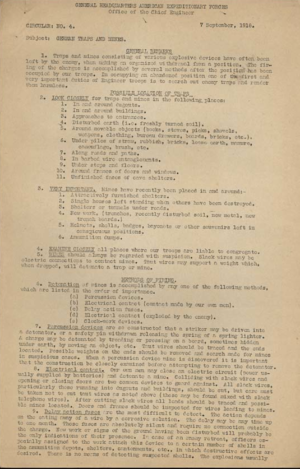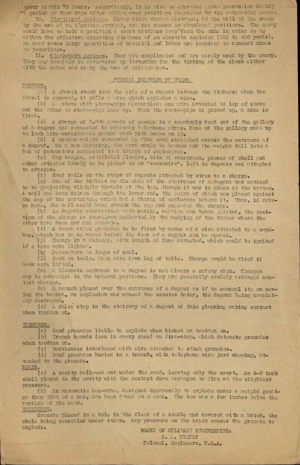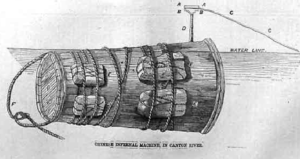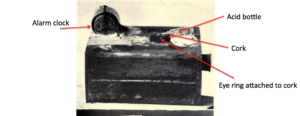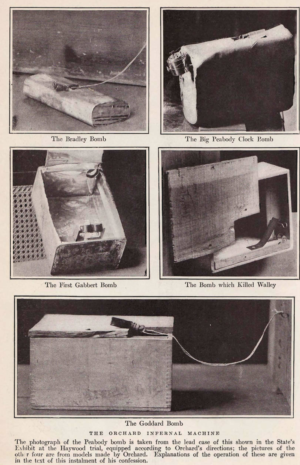Readers may recall that I have blogged before about German IEDs and sabotage devices in the US during the period 1915- 1918, focused on munitions plants and shipping on the US East Coast. I’ve been doing some more research on German IEDs of the period in general and found a remarkable number in Europe right towards the end of the war. A significant number were being left behind when the German army retreated in 1918 and others were being transported from Germany via Norway and Switzerland Some of the IEDs were sophisticated and used some dastardly (love that word) initiation systems. Here’s some examples:
In October 1918, because so many “infernal machines” had been found, US forces adopted a strict policy of clearance of facilities vacated by retreating Germans. Therefore they must have by implication had a significant search and EOD capability. US forces discovered a temperature initiated IED in one dug out left behind by retreating Germans. US ordnance specialists defused the device and assessed that since there were no houses in the area, the Germans expected the advancing Americans to occupy the dug out , and that when they warmed up the space, the switch would have initiated the device. In the dug out they found the temperature switch under a “cot”, with ten large artillery shells buried nearby connected to the switch. On at least one occasion a device left in a bed in a house vacated by German troops detonated killing an allied soldier who lay on it. There are reports of a booby trapped pair of binoculars. As one quote of the time said

There are unsubstantiated reports that the Germans realized how popular their spiked helmets (pickelhaube) were and so frequently booby trapped them.
Another report (written by Col Joseph Hyde of the US 105th Engineers) reported a 300 pound device in a church steeple, connected to a pressure plate where a man might kneel in front of the altar.
In April 1918 , Norwegian authorities discovered one hundred and seven IEDs that had been smuggled into Norway by German agents, with a view to attacking Norwegian shipping. Also recovered were:
104 incendiaries
9 IEDs disguised as lumps of coal
133”strikers”
269 detonators
470 tubes of acid (for delay fusing)
33 pieces of explosives disguised as chewing tobacco
some fountain pens filled with acid as delay initiators
95 large rectangular bombs in iron cases, initiated with a clockwork mechanism
Also in 1918, Swiss authorities discovered a similar plot, which involved German diplomats smuggling sabotage devices and explosives through Switzerland and on to Italy. In a similar manner to the way in which IEDs were manufactured in the US, so the Germans established two bomb making facilities in Switzerland at this time.
Here’s a couple of press clips about the devices, one in a piano in 1916 and one from 1918.
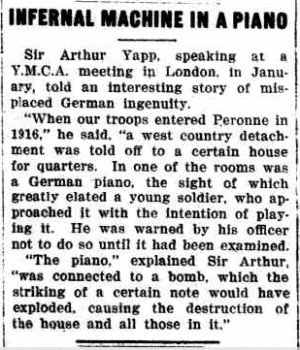
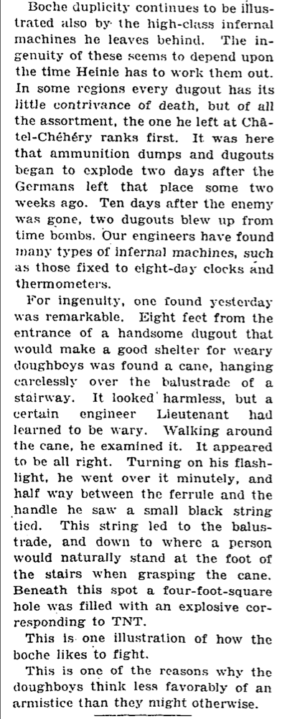
I have found some interesting official US Army documents detailing how common booby traps and other IEDs were towards the end of WW1 – they bear remarkable resemblance to documents detailing the threat in Afghanistan today – I’ll post them in a few days time.
